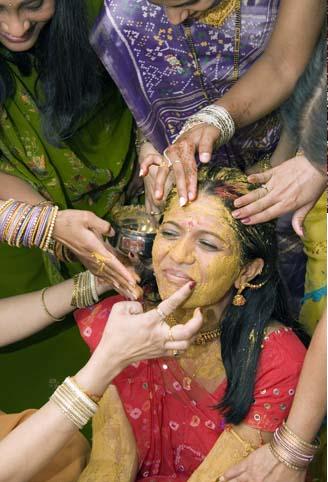
Mayian
Encyclopedia

Mayian is the term used for the wedding preparation ceremony one day before a punjabi Wedding. This ceremony is an evening
Evening
Evening is the period between the late afternoon and night when daylight is decreasing, around dinner time at 6pm. Though the term is subjective, evening is typically understood to begin before sunset, during the close of the standard business day and extend until nightfall, the beginning of night...
festival, at the couple's parental homes. It consists of many rites, the Batna, Choora, Jaggo Fireworks and sometimes the Ladies Sangeet
Sangeet
The term sangeet is Sanskrit which may be translated into English as sung together, or singing with instrumental accompaniment and has several definitions - all of which are derived from its origins.-Classical music study:...
and Mendhi.
The Ceremony
One dayDay
A day is a unit of time, commonly defined as an interval equal to 24 hours. It also can mean that portion of the full day during which a location is illuminated by the light of the sun...
before the wedding, the ceremony of mayian is performed at the couple's respective homes. The prospective bride or groom is seated on a wooden plank called a patri, and a red cloth is held above by four female relatives, while married women of the household and biradari, led by the mother, rub paste of turmeric, flour and mustard oil on his/her face, arms and legs. During the ritual women sing traditional songs and those of the biradari receive the ritual gift of gogley (Punjabi sweets specially cooked for weddings at the end of the ceremony).
Choora
On the morning
Morning
The word morning originally referred to the sunrise. Morning precedes midday, afternoon, and night in the sequence of a day.Morning is the part of the day usually reckoned from dawn to noon...
before the wedding, a ritual of chura (involving a set of ivory and red bangles) is performed at the would-be bride's residence. Her maternal uncle makes a gift of clothes, jewellery and some cash called nankey-shak. He puts the bangles on his niece while the women sing traditional songs depicting the role of maternal uncles. Before the wedding ceremony, the bride-to-be takes a ritual bath and dresses in clothes provided by her maternal uncles, in which she is wed. Similarly, the bridegroom-to-be also receives a set of clothes called jora-jama from his maternal uncles which he, too, wears at the wedding ceremony. It signifies the importance of the role of the mother's natal family at the wedding rituals, and reinforces the alliance established at her (the mother's) own wedding.
Batna
In the Batna rite, the couple's families rub yellow turmeric paste upon their legs, face, and arms while sitting on a patri (a special red board with embroidery) below a red cloth held by four women. This is done to cleanse and balance the body for married life.
Jaggo
In Jaggo ceremony, the family dances and sings on the road in front and around the beautifully-decorated wedding home. Jaggo is in the last hours of the night. Copper vessels called "gaffers" are decorated with divas (clay lamps), filled with mustard oil, and lit. The bride/bridegroom's maternal aunt (mammi) carries it on her head, and another lady carries a long stick with bells, which she shakes. The ladies then go into other friends' and families' homes to be welcomed with sweets and drinks. They dance there and move on. It is a solemn ceremony filled with joy, dancing, fireworks, and food. The Ladies Sangeet (Ladies' Night of Singing) and Mendhi might follow the mayian and dinner.

